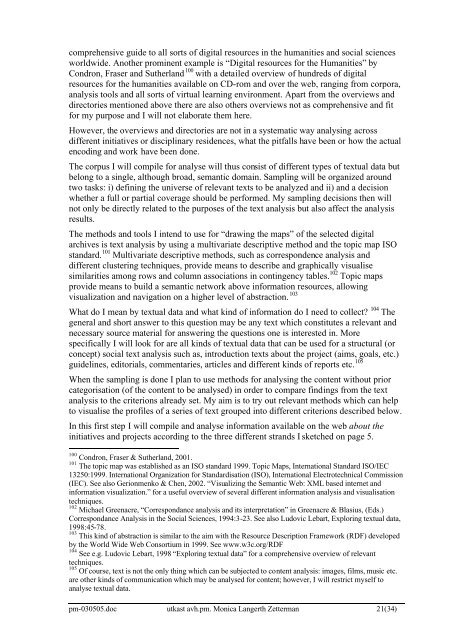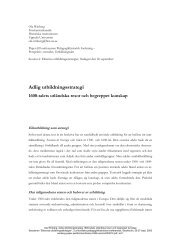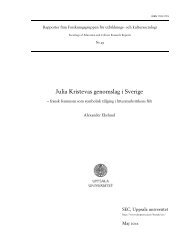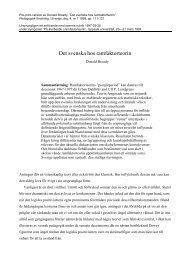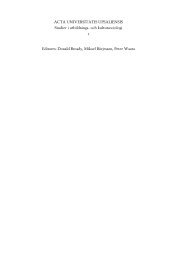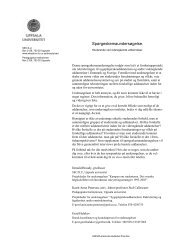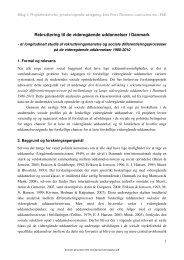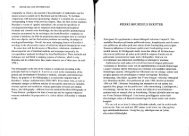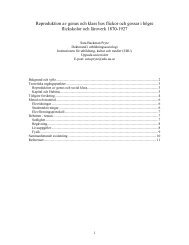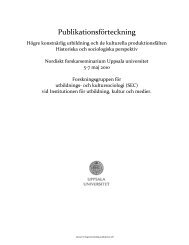exploring uses of digital archives in research and ... - skeptron.uu.se
exploring uses of digital archives in research and ... - skeptron.uu.se
exploring uses of digital archives in research and ... - skeptron.uu.se
Create successful ePaper yourself
Turn your PDF publications into a flip-book with our unique Google optimized e-Paper software.
comprehensive guide to all sorts <strong>of</strong> <strong>digital</strong> resources <strong>in</strong> the humanities <strong>and</strong> social sciencesworldwide. Another prom<strong>in</strong>ent example is “Digital resources for the Humanities” byCondron, Fra<strong>se</strong>r <strong>and</strong> Sutherl<strong>and</strong> 100 with a detailed overview <strong>of</strong> hundreds <strong>of</strong> <strong>digital</strong>resources for the humanities available on CD-rom <strong>and</strong> over the web, rang<strong>in</strong>g from corpora,analysis tools <strong>and</strong> all sorts <strong>of</strong> virtual learn<strong>in</strong>g environment. Apart from the overviews <strong>and</strong>directories mentioned above there are also others overviews not as comprehensive <strong>and</strong> fitfor my purpo<strong>se</strong> <strong>and</strong> I will not elaborate them here.However, the overviews <strong>and</strong> directories are not <strong>in</strong> a systematic way analys<strong>in</strong>g acrossdifferent <strong>in</strong>itiatives or discipl<strong>in</strong>ary residences, what the pitfalls have been or how the actualencod<strong>in</strong>g <strong>and</strong> work have been done.The corpus I will compile for analy<strong>se</strong> will thus consist <strong>of</strong> different types <strong>of</strong> textual data butbelong to a s<strong>in</strong>gle, although broad, <strong>se</strong>mantic doma<strong>in</strong>. Sampl<strong>in</strong>g will be organized aroundtwo tasks: i) def<strong>in</strong><strong>in</strong>g the univer<strong>se</strong> <strong>of</strong> relevant texts to be analyzed <strong>and</strong> ii) <strong>and</strong> a decisionwhether a full or partial coverage should be performed. My sampl<strong>in</strong>g decisions then willnot only be directly related to the purpo<strong>se</strong>s <strong>of</strong> the text analysis but also affect the analysisresults.The methods <strong>and</strong> tools I <strong>in</strong>tend to u<strong>se</strong> for “draw<strong>in</strong>g the maps” <strong>of</strong> the <strong>se</strong>lected <strong>digital</strong><strong>archives</strong> is text analysis by us<strong>in</strong>g a multivariate descriptive method <strong>and</strong> the topic map ISOst<strong>and</strong>ard. 101 Multivariate descriptive methods, such as correspondence analysis <strong>and</strong>different cluster<strong>in</strong>g techniques, provide means to describe <strong>and</strong> graphically visuali<strong>se</strong>similarities among rows <strong>and</strong> column associations <strong>in</strong> cont<strong>in</strong>gency tables. 102 Topic mapsprovide means to build a <strong>se</strong>mantic network above <strong>in</strong>formation resources, allow<strong>in</strong>gvisualization <strong>and</strong> navigation on a higher level <strong>of</strong> abstraction. 103What do I mean by textual data <strong>and</strong> what k<strong>in</strong>d <strong>of</strong> <strong>in</strong>formation do I need to collect? 104 Thegeneral <strong>and</strong> short answer to this question may be any text which constitutes a relevant <strong>and</strong>necessary source material for answer<strong>in</strong>g the questions one is <strong>in</strong>terested <strong>in</strong>. Morespecifically I will look for are all k<strong>in</strong>ds <strong>of</strong> textual data that can be u<strong>se</strong>d for a structural (orconcept) social text analysis such as, <strong>in</strong>troduction texts about the project (aims, goals, etc.)guidel<strong>in</strong>es, editorials, commentaries, articles <strong>and</strong> different k<strong>in</strong>ds <strong>of</strong> reports etc. 105When the sampl<strong>in</strong>g is done I plan to u<strong>se</strong> methods for analys<strong>in</strong>g the content without priorcategorisation (<strong>of</strong> the content to be analy<strong>se</strong>d) <strong>in</strong> order to compare f<strong>in</strong>d<strong>in</strong>gs from the textanalysis to the criterions already <strong>se</strong>t. My aim is to try out relevant methods which can helpto visuali<strong>se</strong> the pr<strong>of</strong>iles <strong>of</strong> a <strong>se</strong>ries <strong>of</strong> text grouped <strong>in</strong>to different criterions described below.In this first step I will compile <strong>and</strong> analy<strong>se</strong> <strong>in</strong>formation available on the web about the<strong>in</strong>itiatives <strong>and</strong> projects accord<strong>in</strong>g to the three different str<strong>and</strong>s I sketched on page 5.100 Condron, Fra<strong>se</strong>r & Sutherl<strong>and</strong>, 2001.101 The topic map was established as an ISO st<strong>and</strong>ard 1999. Topic Maps, International St<strong>and</strong>ard ISO/IEC13250:1999. International Organization for St<strong>and</strong>ardisation (ISO), International Electrotechnical Commission(IEC). See also Gerionmenko & Chen, 2002. “Visualiz<strong>in</strong>g the Semantic Web: XML ba<strong>se</strong>d <strong>in</strong>ternet <strong>and</strong><strong>in</strong>formation visualization.” for a u<strong>se</strong>ful overview <strong>of</strong> <strong>se</strong>veral different <strong>in</strong>formation analysis <strong>and</strong> visualisationtechniques.102 Michael Greenacre, “Correspondance analysis <strong>and</strong> its <strong>in</strong>terpretation” <strong>in</strong> Greenacre & Blasius, (Eds.)Correspondance Analysis <strong>in</strong> the Social Sciences, 1994:3-23. See also Ludovic Lebart, Explor<strong>in</strong>g textual data,1998:45-78.103 This k<strong>in</strong>d <strong>of</strong> abstraction is similar to the aim with the Resource Description Framework (RDF) developedby the World Wide Web Consortium <strong>in</strong> 1999. See www.w3c.org/RDF104 See e.g. Ludovic Lebart, 1998 “Explor<strong>in</strong>g textual data” for a comprehensive overview <strong>of</strong> relevanttechniques.105 Of cour<strong>se</strong>, text is not the only th<strong>in</strong>g which can be subjected to content analysis: images, films, music etc.are other k<strong>in</strong>ds <strong>of</strong> communication which may be analy<strong>se</strong>d for content; however, I will restrict my<strong>se</strong>lf toanaly<strong>se</strong> textual data.pm-030505.doc utkast avh.pm. Monica Langerth Zetterman 21(34)


